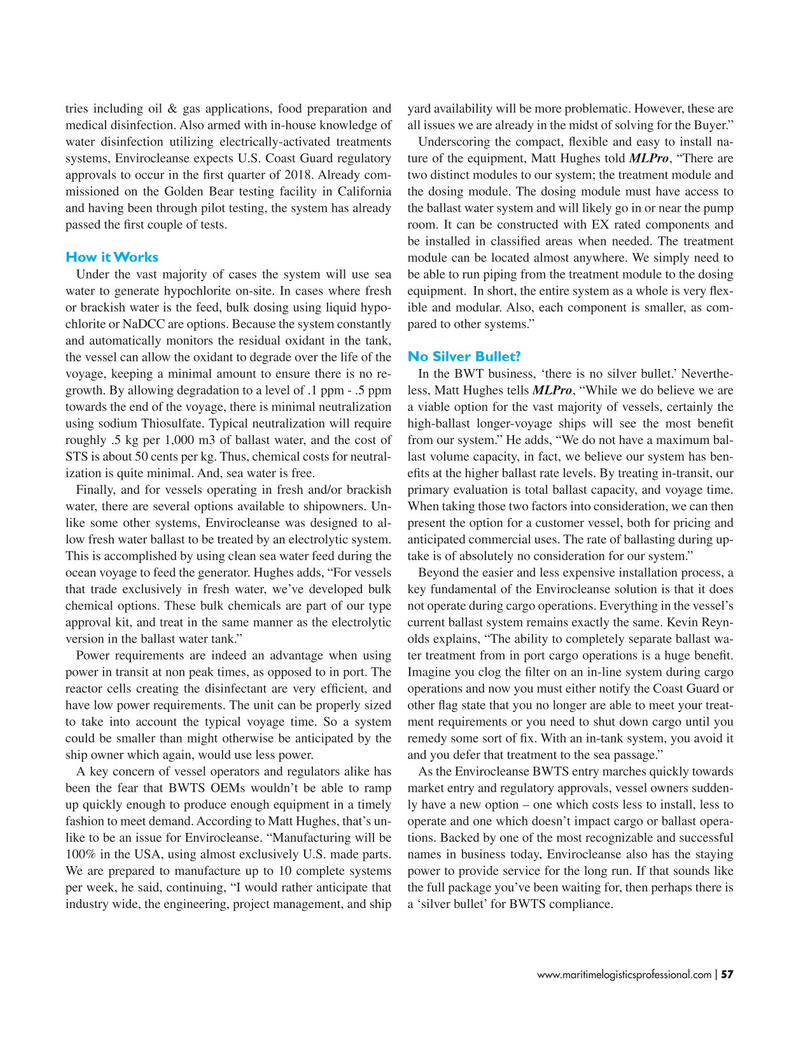
Page 57: of Maritime Logistics Professional Magazine (Mar/Apr 2017)
IT & SOFTWARE
Read this page in Pdf, Flash or Html5 edition of Mar/Apr 2017 Maritime Logistics Professional Magazine
tries including oil & gas applications, food preparation and yard availability will be more problematic. However, these are medical disinfection. Also armed with in-house knowledge of all issues we are already in the midst of solving for the Buyer.” water disinfection utilizing electrically-activated treatments Underscoring the compact, ? exible and easy to install na- systems, Envirocleanse expects U.S. Coast Guard regulatory ture of the equipment, Matt Hughes told MLPro, “There are approvals to occur in the ? rst quarter of 2018. Already com- two distinct modules to our system; the treatment module and missioned on the Golden Bear testing facility in California the dosing module. The dosing module must have access to and having been through pilot testing, the system has already the ballast water system and will likely go in or near the pump passed the ? rst couple of tests. room. It can be constructed with EX rated components and be installed in classi? ed areas when needed. The treatment
How it Works module can be located almost anywhere. We simply need to
Under the vast majority of cases the system will use sea be able to run piping from the treatment module to the dosing water to generate hypochlorite on-site. In cases where fresh equipment. In short, the entire system as a whole is very ? ex- or brackish water is the feed, bulk dosing using liquid hypo- ible and modular. Also, each component is smaller, as com- chlorite or NaDCC are options. Because the system constantly pared to other systems.” and automatically monitors the residual oxidant in the tank, the vessel can allow the oxidant to degrade over the life of the No Silver Bullet?
voyage, keeping a minimal amount to ensure there is no re- In the BWT business, ‘there is no silver bullet.’ Neverthe- growth. By allowing degradation to a level of .1 ppm - .5 ppm less, Matt Hughes tells MLPro, “While we do believe we are towards the end of the voyage, there is minimal neutralization a viable option for the vast majority of vessels, certainly the using sodium Thiosulfate. Typical neutralization will require high-ballast longer-voyage ships will see the most bene? t roughly .5 kg per 1,000 m3 of ballast water, and the cost of from our system.” He adds, “We do not have a maximum bal-
STS is about 50 cents per kg. Thus, chemical costs for neutral- last volume capacity, in fact, we believe our system has ben- ization is quite minimal. And, sea water is free. e? ts at the higher ballast rate levels. By treating in-transit, our
Finally, and for vessels operating in fresh and/or brackish primary evaluation is total ballast capacity, and voyage time. water, there are several options available to shipowners. Un- When taking those two factors into consideration, we can then like some other systems, Envirocleanse was designed to al- present the option for a customer vessel, both for pricing and low fresh water ballast to be treated by an electrolytic system. anticipated commercial uses. The rate of ballasting during up-
This is accomplished by using clean sea water feed during the take is of absolutely no consideration for our system.” ocean voyage to feed the generator. Hughes adds, “For vessels Beyond the easier and less expensive installation process, a that trade exclusively in fresh water, we’ve developed bulk key fundamental of the Envirocleanse solution is that it does chemical options. These bulk chemicals are part of our type not operate during cargo operations. Everything in the vessel’s approval kit, and treat in the same manner as the electrolytic current ballast system remains exactly the same. Kevin Reyn- version in the ballast water tank.” olds explains, “The ability to completely separate ballast wa-
Power requirements are indeed an advantage when using ter treatment from in port cargo operations is a huge bene? t. power in transit at non peak times, as opposed to in port. The Imagine you clog the ? lter on an in-line system during cargo reactor cells creating the disinfectant are very ef? cient, and operations and now you must either notify the Coast Guard or have low power requirements. The unit can be properly sized other ? ag state that you no longer are able to meet your treat- to take into account the typical voyage time. So a system ment requirements or you need to shut down cargo until you could be smaller than might otherwise be anticipated by the remedy some sort of ? x. With an in-tank system, you avoid it ship owner which again, would use less power. and you defer that treatment to the sea passage.”
A key concern of vessel operators and regulators alike has As the Envirocleanse BWTS entry marches quickly towards been the fear that BWTS OEMs wouldn’t be able to ramp market entry and regulatory approvals, vessel owners sudden- up quickly enough to produce enough equipment in a timely ly have a new option – one which costs less to install, less to fashion to meet demand. According to Matt Hughes, that’s un- operate and one which doesn’t impact cargo or ballast opera- like to be an issue for Envirocleanse. “Manufacturing will be tions. Backed by one of the most recognizable and successful 100% in the USA, using almost exclusively U.S. made parts. names in business today, Envirocleanse also has the staying
We are prepared to manufacture up to 10 complete systems power to provide service for the long run. If that sounds like per week, he said, continuing, “I would rather anticipate that the full package you’ve been waiting for, then perhaps there is industry wide, the engineering, project management, and ship a ‘silver bullet’ for BWTS compliance. www.maritimelogisticsprofessional.com 57
I

 56
56

 58
58
